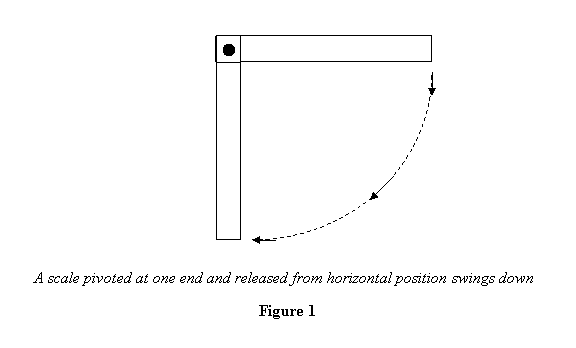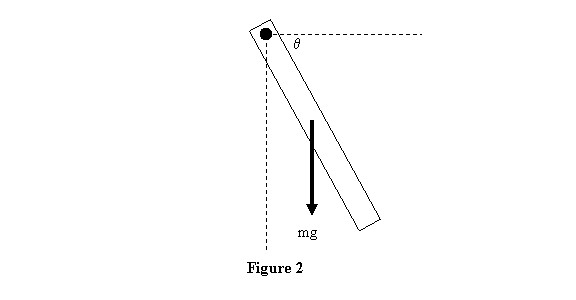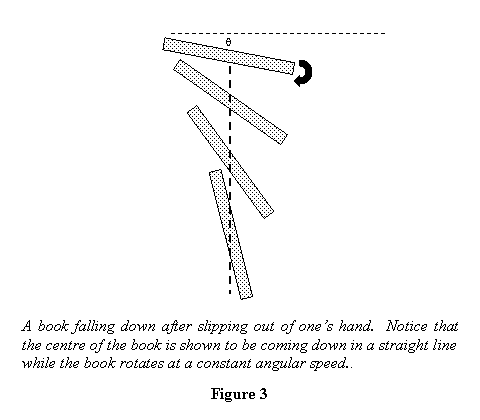Lecture 20
Rigid
body dynamics III: Rotation
and Translation
We have seen in the past two lectures how do we go about
solving the rigid body dynamics problem by considering
the rate of change of angular momentum. In the previous
lecture, we concentrated on rotation about a fixed axis
and solved problems involving conservation of angular
momentum about that axis. In this lecture we consider
what happens where an external torque is applied and
also when the axis is allowed to translate parallel to
itself.
Let us first take the case when the axis is stationary
and a torque is applied. Take for instance your pen or
a scale and hold it lightly at one of its ends so as
to pivot it there. Raise the other end so that the scale
is horizontal and then leave it. You will see that the
scale swings down. I would like to calculate the speed
of its CM when the scale is vertical after being released
from horizontal position (see figure 1). Assume that
there is no loss due to friction. In this case I will
solve this problem in two ways and also comment on a
wrong way.

I
take the mass of the scale to be m and
its length l. Then its moment of inertia
about one of its ends is  . .
I first solve the problem using energy conservation. Since
there is no loss due to friction the total mechanical
energy is conserved. Therefore the total mechanical energy
is conserved. Let us take the potential energy to be
zero when the scale is horizontal. Since the scale starts
with zero initial angular speed, its total mechanical
energy is zero. When the scale reaches the vertical position,
its CM has moved down by a distance  so
its potential energy is so
its potential energy is  .
If its angular speed at that position is ω, then by
conservation of energy .
If its angular speed at that position is ω, then by
conservation of energy

which gives

I now solve the problem by a direct application of torque
equation. When the scale makes an angle θ from the horizontal
(see figure 2), the torque on it is given as


The angular momentum-torque equation then gives

Substituting  and
the value of I from above this leads to and
the value of I from above this leads to

This equation cannot be integrated with respect to time
directly. Recall from the proof of work-energy theorem
that in such situations we change transform the equation
to write it in terms of the displacement variable, which
is the angle in this case. So we write

to write the equation above as

Integrating this equation then gives

For  this
gives the same answer as obtained earlier. If you have
noticed, what we have done here is actually used the
work-energy theorem this
gives the same answer as obtained earlier. If you have
noticed, what we have done here is actually used the
work-energy theorem
You may ask at this point: wouldn't the correct way of
solving this problem be to equate the kinetic energy
of the CM to the change in the potential energy. This
would lead to

The reason why this answer is incorrect is the following.
Recall from our previous lecture that the most general
motion of a rigid body is a translation plus a rotation.
So while it is true that the CM is moving, the scale
is also rotating at the same time. We represent the combination
of the two motions as a translation of the CM and a rotation
about an axis passing through the CM. Why we split the
motion of the scale as a combination of the translation
of its CM and a rotation about the CM - and not that
of any other point in the body - will be discussed in
detail below. For now it is sufficient to say that by
doing so the kinetic energy can be written conveniently
as (KE of the CM plus KE about the CM). So the true K.E
of the scale is

where  is
the moment of inertia about the CM. Using the relationship is
the moment of inertia about the CM. Using the relationship  this
gives the same kinetic energy as that used above in applying
the energy conservation method. This correct approach
then gives the same answer as obtained above. this
gives the same kinetic energy as that used above in applying
the energy conservation method. This correct approach
then gives the same answer as obtained above.
An interesting problem related to the one solved above
is as follows. Sometimes if a book you are holding slips
out your hand, it usually falls with its upper face down
(see figure 3). You can try this at home and see for
yourself. In fact there is an interesting book which
has a title based on this observation. It is entitled "Why
toast lands jelly side down" and is authored by Robert
Ehrlich (Universities press, Hyderabad 1999). Let us
try to understand this observation.

When the book falls its angular acceleration α immediately
after it slips off the hand is calculated approximately
as given below

Here m is the mass of the book and l its
length. I call it an approximate expression because in
our calculation we have assumed the book to be in horizontal
position. It will slip off when  or
for small angles θ ~ µ, where m is
the coefficient of friction between the book and the
hand. Starting with zero initial angular speed, let the
angular speed of the book when it slips out of the hand
be ω . Then or
for small angles θ ~ µ, where m is
the coefficient of friction between the book and the
hand. Starting with zero initial angular speed, let the
angular speed of the book when it slips out of the hand
be ω . Then

Taking µ = 0.5, g = 10ms- 2 and l
= 20cm = 0.2m , we get
ω = 8.7 rad s- 1
After the book has come out of the hands, there is no
external torque on it about its CM so it falls rotating
with a constant angular speed of about 8.7rad s-
1. Keep in mind that the sense and amount of rotation
of a rigid body is the same irrespective of the point
about which its rotation is considered. So although before
slipping out of the hand, I did the calculation for its
angular speed taking its edge on the hand as the axis,
after it comes out of the hand, I consider its motion
as the translation of its CM and rotation about its CM.
Let us stake a typical height of about 1m from which
the book falls. Then the time it takes to reach the ground
is

Thus the angle through which the book rotates by the time
it reaches the ground is

If we add to this angle the initial rotation of θ = µ =
0.5, the angle increases to about 250°. The angle
of rotation of course varies in a range but it is around
180°.You see that the book has just the right angular
speed and the time of fall for it to turn by around 180°.
That is precisely what we observe.
|